






Academic Authors: Kashika Parnami, Arpit Agarwal, Urmi Maitra, Anuj Gupta
Creative Directors: Bhavna Tripathi, Mangal Singh Rana, Satish
Book Production: Rakesh Kumar Singh, Sanjay Kumar Goel
Project Lead: Chandani Goyal
VP, Learning: Abhishek Bhatnagar
All products and brand names used in this book are trademarks, registered trademarks or trade names of their respective owners.
© Uolo EdTech Private Limited
First impression 2024
Second impression 2025
This book is sold subject to the condition that it shall not by way of trade or otherwise, be lent, resold, hired out, or otherwise circulated without the publisher’s prior written consent in any form of binding or cover other than that in which it is published and without a similar condition including this condition being imposed on the subsequent purchaser and without limiting the rights under copyright reserved above, no part of this publication may be reproduced, stored in or introduced into a retrieval system, or transmitted in any form or by any means, electronic, mechanical, photocopying, recording or otherwise, without the prior written permission of both the copyright owner and the above-mentioned publisher of this book.
Book Title: Aware General Knowledge 1
ISBN: 978-81-980193-1-8
Published by Uolo EdTech Private Limited
Corporate Office Address:
85, Sector 44, Gurugram, Haryana 122003
CIN: U74999DL2017PTC322986
Illustrations and images: www.shutterstock.com, www.stock.adobe.com and www.freepik.com
All suggested use of the internet should be under adult supervision.
In the dynamic and ever-changing world of the 21st century, knowledge is a beacon that guides us through the myriad challenges and opportunities that come our way. In this age of information, possessing a keen sense of general knowledge and awareness has become more critical than ever before. This awareness becomes a compass that helps us navigate through the complexities of our modern existence, allowing us to make informed decisions, think critically, and appreciate the world’s diversity.
The NEP (National Education Policy) 2020 emphasises the need to develop in learners the respect towards fundamental duties and constitutional values, generate awareness on one’s roles and responsibilities in a dynamic world, foster a sense of national pride and global citizenship.
On that note, we are delighted to present this comprehensive and engaging General Knowledge and Current Affairs book, designed specifically for learners in grades 1 to 8. This book, which spans nine thoughtfully curated themes, will serve as a constant companion in the quest for knowledge and awareness.
The world is evolving at an unprecedented pace, and it’s crucial that young minds are well-informed about the happenings around them. Topics in The Year Gone By theme offer insights into the significant events and milestones of the previous year.
In Science and Technology, learners explore groundbreaking innovations and discoveries that are actively defining and shaping our future.
In Earth and Environment, learners explore topics related to sustainability and environmental conservation. Recognising the delicate balance in our planet’s ecosystem and the paramount importance of preserving it are vital 21st-century skills.
In International Affairs, learners explore landmark global events of the past and the present, and developments across the world.
The theme Incredible India will help learners to explore the rich tapestry of our nation’s history, culture and heritage.
In Sports, learners explore the world of games, athletes, and the importance of teamwork and physical fitness.
The theme, Art and Culture enables the learners to appreciate human creativity, celebrate diverse traditions and discover the rich heritage of human expression across the world.
Life Skills and Financial Literacy provide learners with valuable practical skills essential for navigating their lives with confidence and competence.
This book is crafted to offer informative and enjoyable learning experiences, incorporating clear explanations, captivating visuals and abundant questions for interactive classroom engagement.
This book is supplemented by a digital and interactive learning platform. QR codes in each topic facilitate compatibility with smart classrooms and enable at-home access. The digital resources include topic-specific videos and learning experiences on current affairs and developments around the world.
Welcome to the world of General Knowledge and Current Affairs! We wish the best to all the teachers and learners!

The helps us type letters and numbers.
Label the parts of a computer.
It is like the brain of the computer.
We use a mouse to click on and select things.
We use the keyboard to type letters and numbers.










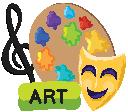



Art and


The National Education Policy (NEP) outlines essential skills, values, dispositions and learning approaches necessary for learners to thrive in the 21st century. Aware incorporates these elements throughout its content, tasks, and projects. Referred to as ‘NEP Tags,’ they are defined as follows:



21st SKILLS





Bringing creativity and fun into learning by combining music, drama and art
Higher-Order
Encouraging higher-order skills such as analyzing, evaluating, problem-solving and fostering deep understanding




Green Living
Unwavering commitment to generating awareness of a green, peaceful and prosperous world
Fostering skills and knowledge—such as critical thinking, communication, and digital literacy—that are essential for success in today’s rapidly changing world
Health and Wellness
Promoting practices that support physical, mental, and emotional well-being for a balanced and healthy lifestyle

Moral and
Building strong character, guiding towards ethical decision making, and developing respect, kindness, and a sense of responsibility




Food is important for us. A lot of food that we eat comes from plants.
























We should eat vegetables, fruits, cereals and pulses every day. They make us big, healthy and strong. We should always share food with our family and friends.
1 Match the following. Pulse Spice Grain



2 Draw your favourite fruit. Colour it. Scan this QR code to see the quiz. Practice Time



A computer is a machine. It has many parts. It helps us do many things.
To study Watch videos Listen to music Play video games

Monitor: It is like a TV screen. We can see pictures, words and videos on it.
CPU: It is like the brain of the computer.
Keyboard: We use the keyboard to type letters and numbers.
Mouse: We use a mouse to click on and select things.
We should not look at a computer for too long. It can harm our eyes.
We should use a computer only when our parents and teachers are around.
Practice Time
1 Tick () the correct answers.

Scan this QR code to see the quiz.
a We can using a computer.
i study ii travel
iii eat iv run
b The helps us type letters and numbers.
i monitor ii keyboard
iii CPU iv mouse
2 Label the parts of a computer.
The National Flag of India is called the Tiranga. Let us learn about our National Flag.

Shape and Colour
It is rectangular in shape. It has three colours:
• Saffron at the top.
• White in the middle with a blue chakra (wheel). This wheel has 24 spokes.
• Green at the bottom.
Importance of Our National Flag
The National Flag of India unites the people. It is the pride of our country.
Special Days When the National Flag Is Hoisted
1. On Independence Day at the Red Fort in Delhi.
2. On Republic Day at Kartavya Path in Delhi.




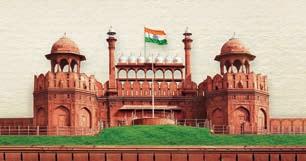
We should always respect our National Flag.
Practice Time


Scan this QR code to see the quiz.
1 Circle the colours in the National Flag of India and colour the flag.
white yellow green black blue saffron
2 Tick () two special days on which the National Flag is hoisted.
Republic Day
Children’s Day Independence Day Holi
The park is where we go to have fun. We ride on swings and play
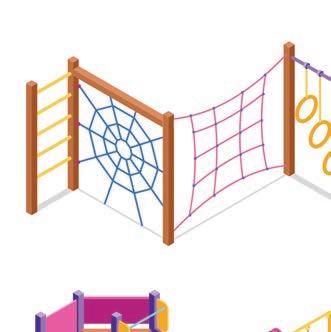
I am going down a slide.

We are swinging on a swing.

We are going up and down on a seesaw.

Some other activities that we enjoy at the park are:
We are playing in a sandbox.
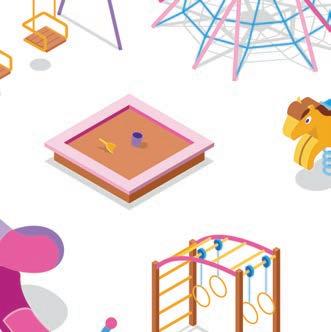
Moving up and down on a spring rider
Going to the park helps us stay fit. It keeps us healthy and strong.
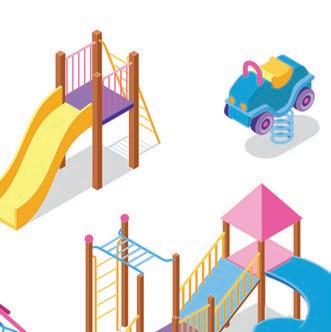



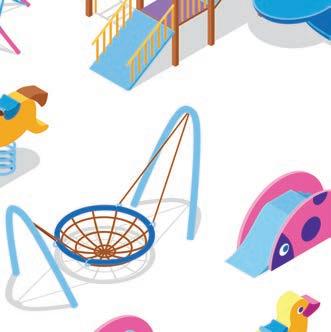



Practice Time

Scan this QR code to see the quiz.
1 Match the pictures and the correct ride.
a seesaw
b monkey bars
c swing
d merry-go-round
2 A boy went to the park to play in a sandbox. Help the boy reach the sandbox.
We need to follow rules while walking and driving on the roads. Let us learn about them.
It has three lights.
RED: Stop!
YELLOW: Slow down! / Get ready!
Green: Go!
Do
Do




















We should cross the road on the zebra crossing.
Always follow traffic signals on the road.
Practice Time

Scan this QR code to see the quiz.
1 Match the signs to their correct meanings.
You can park
To stop
No honking
No parking

2 Colour the traffic lights. Then, fill in the blanks with their meanings.
a colour means SLOW DOWN.
b colour means GO.
c colour means STOP
There are many animals and birds in the world. Let us learn about some of them.
A zebra has black and white stripes on its body.

An elephant has a long nose called a trunk. It has large teeth called tusks.
A giraffe has a very long neck. It has spots on its body.
An ostrich is a bird that cannot fly. It can run very fast.
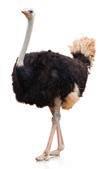







A peacock has long and colourful feathers.

Always be kind to animals and birds. Do not hurt them.
Practice Time

Scan this QR code to see the quiz.
1 Match the pictures with the animals they belong to.


2 Who am I? Identify the animals and fill their names in the puzzle.
Ostrich Zebra Elephant Giraffe
Across
1. I have a long neck.
2. I am a bird that cannot fly.
Down
3. I have a long nose called trunk.
4. I have black and white stripes.
We go to school, work and many other places. We use different vehicles to go to these places.
Some vehicles are used by everyone. They are called public vehicles. They are not just used by one person or family.

Some vehicles are used only by you and your family. They are called personal vehicles.



We should use public vehicles more. It helps to save the environment.
Scan this QR code to see the quiz. Practice Time
1 Circle the vehicles that we can keep only for personal use.

2 Find a way for the school bus to reach the school.



Different festivals are celebrated in India. Festivals are fun. Let us read about them.











Diwali is the festival of lights. We decorate our homes. We light clay lamps (diyas). Holi is the festival of colours. We play with colourful powder (gulal) and eat sweets.
Christmas is celebrated on 25 December every year. We decorate a Christmas tree.
Pongal is the festival to thank the Sun. People make a sweet rice dish called pongal.
Gurpurab is celebrated on Guru Nanak Dev’s birthday. We go to the Gurudwaras.


Eid ul-Fitr is celebrated after a monthlong fast. We wear new clothes. We also eat sweet seviyan.
We should enjoy festivals with our family and friends.
Practice Time

Scan this QR code to see the quiz.
1 Match the festivals and the things related to them.
a Diwali
b Christmas
c Holi
d Eid ul-Fitr


2 Tick () the correct festival.
a It is the festival of lights. Pongal Diwali
b It is the festival of colours. Holi Eid ul-Fitr
c It is celebrated on 25 December every year.
d It is celebrated on Guru Nanak Dev’s birthday.
e It is celebrated after a month-long fast.
Gurpurab Christmas
Gurpurab Diwali
Holi
Eid ul-Fitr
We play different types of sports. Let us learn about some sports and how we play them.

We need a ball to play it.
Lawn Tennis
We need a racket and a shuttlecock to play it.
Table Tennis
We need a racket and a tennis ball to play it.
We need a bat, ball and stumps to play it. Cricket
We need a table, a paddle and a ball to play it.
We need a J-shaped stick and a ball to play it. Hockey
Sports help you learn to work as a team.
Practice Time


Scan this QR code to see the quiz.
1 Colour what we use to play the sport.
a Cricket b Table Tennis c Badminton
2 Read the text. Underline the correct sport.
a It is played on a table. table tennis badminton
b It is played with a racket and a ball. badminton lawn tennis
c It is played with a J-shaped stick. hockey table tennis
d It is played using a shuttlecock. hockey badminton
e It uses six stumps. cricket hockey

We can make many dishes with the help of an adult. Let us learn to make a few dishes.
Things we need: 2 slices of bread, butter, 4-5 slices of tomato, chopped lettuce and a slice of cheese.
Take a slice of bread. Spread some butter on it.
Put some chopped lettuce on it.

Ask an adult to cut it in half. The sandwich is ready.
Cover it with the second slice of bread.
Put the slice of cheese on the lettuce.
Add slices of tomato on top of the cheese.
Things we need: A glass of water, 1 or 2 slices of lemon, salt and sugar, mint leaves and ice cubes.

Add lemon juice to half a glass of water.


Add salt and sugar. Then, mix it all together. Add mint leaves, slices of lemon and some ice cubes. Enjoy your lemonade.
We should wash fruit and vegetables before we use them.
Practice Time

Scan this QR code to see the quiz.
1 Circle what we need to make the dishes.
a Lemonade mint leaves tea leaves lemons sugar
b Sandwich sugar a cheese slice banana slices bread slices
2 Number the steps (1–4) in the correct order to make a tomato cheese sandwich.

The ICC Men’s T20 World Cup is a cricket tournament. Twenty teams took part in it.
India won the 2024 ICC Men’s T20 World Cup.
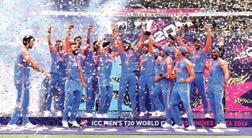
The captain of the Indian team was Rohit Sharma.


India beat South Africa in the finals.

Jasprit Bumrah won the ‘Player of the Tournament’ award.

Teamwork and confidence helped India win this tournament.
Practice Time
1 Tick () the correct options.

Scan this QR code to see the quiz.
a The 2024 ICC Men’s T20 World Cup was won by:
i India
ii USA
b The captain of the Indian team was:
i Virat Kohli
ii Rohit Sharma
c He won the ‘Player of the Tournament’ in 2024 ICC Men’s T20 World Cup:
i Jasprit Bumrah
ii Hardik Pandya
d The number of teams that took part in the tournament was:
i 20

ii 12
2 Colour your Indian jersey. Also, write your name on the back.

A beach is where the ocean or sea water meets the land. There are so many things to do and see at the beach.
We
Play different games Drink coconut water Make sandcastles Collect seashells

We should keep the beach clean.
What is your favourite activity to do at the beach?


Practice Time
1 Circle the things you will find at a beach.
2 Connect the dots to complete the picture. Then, colour it. Scan this QR code to see the quiz.
seashells cars sand trees traffic lights starfish roads waves



When we stand outside and look up, we see the sky. Let us learn about the things we see in the sky.
We can see the Sun in the sky. The Sun is a big ball of fire. It gives us light.











The Sun rises in the east and sets in the west.





Clouds have many shapes. Some clouds cause rain. Rainy clouds are dark.



Sometimes, we see a rainbow in the sky, after it rains. A rainbow has seven colours—violet, indigo, blue, green, yellow, orange and red (VIBGYOR).
We can see the Moon. The shape of the Moon changes every night.
Stars shine in the night sky. They look small because they are very far away from the Earth.
Look at the sky for three days. Do you see any changes in the day sky and the night sky?
Practice Time
1 Fill in the blanks.

Scan this QR code to see the quiz.
a The Sun sets in the .
b Rainy clouds are .
c There are colours in a rainbow.
d The Moon changes its every night.
e look small because they are far from the Earth.

2 Trace the picture of the rainbow. Colour the rainbow using the VIBGYOR colours.

India has different types of music. We use different instruments to make music. Let us learn about some of them.
This is a harmonium. It is played using a flap and keys.
This is a tabla. It is played using hands and fingers.

This is a sitar. It has many strings. It is played by pulling the strings.
This is a bansuri. It is played by blowing air into it.
Listening to music can make us happy.
Practice Time
1 Match the pictures and their names.
Scan this QR code to see the quiz.


2 Look at the picture. Write the name of the instrument and colour it. This is a .

Money is something people use to buy things they need or want. Let us learn more about money.
Money can be coins or notes (on paper).
The type of money used in a country is called its currency. The Indian Rupee (INR) is the currency of India.








Indian rupee coins
Indian rupee notes
A long time ago, some other things were used as money. These were:
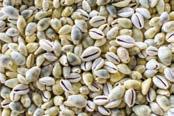



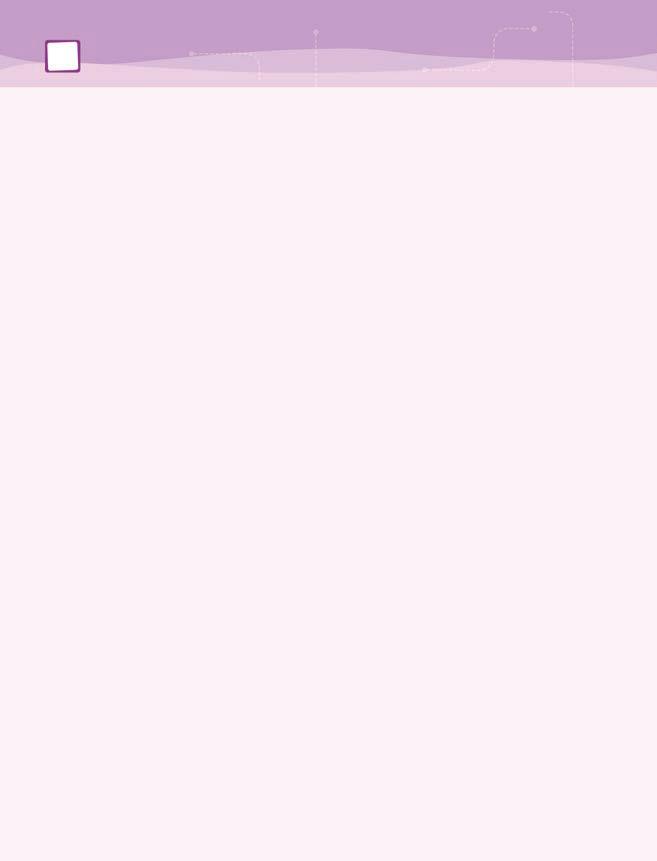
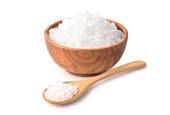
We should keep some amount of money aside. This is called saving money.
It is important to save money for the future.

Scan this QR code to see the quiz.
1 Tick () the items that were used as money in earlier times.






2 Write ‘T’ for true and ‘F’ for false.
a We need money to buy things.
b Money can only be in the form of a coin.
c The type of money used in a country is called its currency.
d The currency of India is the Indian Dinar.
e It is important to save money.
The house next to ours belongs to our neighbours. Similarly, the countries right next to India are our neighbouring countries. Let us learn more about these countries.
This country is China.
This country is Nepal.
This country is Afghanistan.
This country is Bhutan.
This country is Pakistan.
This country is Myanmar.





This country is Bangladesh.


This country is Maldives.
This country is Sri Lanka.
We should always be polite to our neighbours and live happily with each other.




Practice Time

Scan this QR code to see the quiz.
1 Circle the countries which are India’s neighbours.
Australia China Sri Lanka Russia
USA Bangladesh Brazil Nepal

2 Colour China with green and Myanmar with orange.
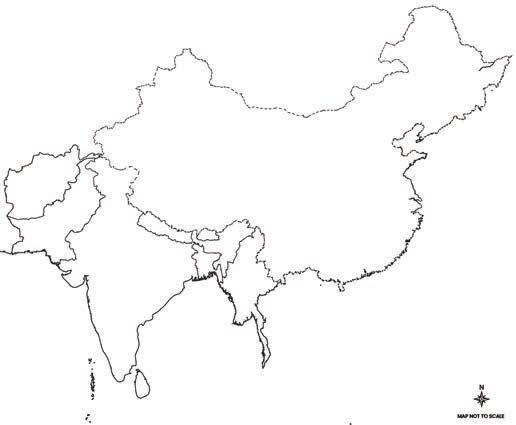

Watching cartoons is fun. Let us meet some famous cartoon characters.

Hi, I am Doraemon. I am a robot cat from the future. I have many gadgets. I help my best friend, Nobita.
Hello! I am Masha. I am a naughty little girl. This Bear is my best friend.

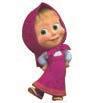
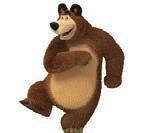
Hi, I am Chhota Bheem. I love to eat laddoos. I live in Dholakpur.
Hi, I am Dora the Explorer. I go to different places with Boots. He is my best friend. My backpack has many tools.


Hi, we are Motu and Patlu. We are from Furfuri Nagar. We always get into trouble, but we come out of it.
Who is your favourite cartoon character? Why do you like them?
Practice Time

Scan this QR code to see the quiz.
1 Who am I? Write my name.
Motu and Patlu Dora the Explorer Chhota Bheem Masha Doraemon
a I go to different places with Boots.
b My best friend is Bear.
c We live in Furfuri Nagar.
d I am a robot from the future.
e I love to eat laddoos.
2 Draw lines to help Dora reach Boots.

It is important to stay healthy and fit. Let us learn some ways to stay fit.

Walk or run.
Ride a bicycle.
Do exercise or yoga.
Play outside.
Eat healthy food.

Sleep well and take proper rest.
Cycling helps us to stay fit. It also helps us to save the environment.

Scan this QR code to see the quiz.
1 Tick () the activities that keep us fit and active.
Practice Time running playing video games playing outside taking proper rest
2 Ishaan likes to eat healthy food. Help Ishaan reach the fruit.



The Olympics are the biggest sports event. They take place every four years. People from more than 200 countries take part in it.

The 2024 Olympics were held in Paris. India won six medals.

Neeraj Chopra won the silver medal.
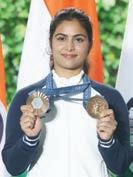


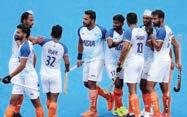
The Indian Hockey Team won the bronze medal.
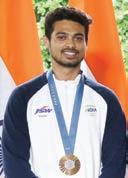
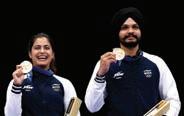
Manu Bhaker and Sarabjot Singh won the bronze medal as a team.

We should work hard to make our country proud.

1 Tick () the correct options.

Scan this QR code to see the quiz.
a The 2024 Olympics were held in .
i Delhi
ii Paris
b The Olympics are held after every years.
i four
ii two
c India won medals in the 2024 Olympics.
i six
ii five
d Neeraj Chopra won a medal in the 2024 Olympics.
i bronze
ii silver
e In the 2024 Olympics, the Indian hockey team won a medal.
i bronze ii silver
2 Colour the Olympics logo.

We throw away things that are no longer useful. Let us learn about how to throw away the waste.

Hello! I am a dustbin. You all throw waste inside me.


Wet Waste Dry Waste

Harmful Waste
Please do not mix up your waste.
We must throw different types of waste in different dustbins. This is called sorting our waste.
Let us see some examples of wet, dry and harmful wastes.
Wet Waste
Dry Waste

Leftover food
Vegetable and fruit peels
Leaves
Flowers

Harmful Waste

Plastic bottles
Food packets
Juice cans
Waste paper
Sorting waste helps us to keep the environment clean.

Medicines
Wires
Old batteries
Old bulbs


Scan this QR code to see the quiz.
1 Colour the dustbins to show the kind of waste thrown in them.
2 Cross () the odd one out.
a Harmful Waste wires old bulbs plastic bottles medicines
b Wet Waste fruit peels batteries leaves flowers
c Dry Waste waste papers juice cans food packets leftover food

A machine is a thing that makes our work easier. They save our time. Let us learn more about machines.
Machines help us move from one place to another using wheels. All vehicles are machines.
Machines can do work that we cannot do.
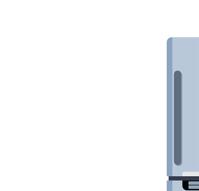










Machines can also be used to learn new things and for fun.





Machines are very helpful. Think of two more machines that you use in your daily life.
Scan this QR code to see the quiz.
1 Tick () the machines that are used for learning new things.


2 Circle the odd one out.



a Machines we use to move from one place to another. i bus
bicycle
b Machines we use to learn new things.
computer
tablet
c Machines that can do work which we cannot do.
iron
fridge
iron
AC
There are many monuments in India. Let us read about some of them.
The Taj Mahal is in Agra, Uttar Pradesh.
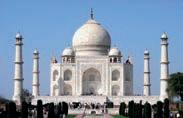
The Sanchi Stupa is in Sanchi, Madhya Pradesh.

The Hawa Mahal is in Jaipur, Rajasthan.
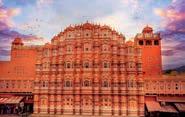


The Charminar is in Hyderabad, Telangana.


The Qutub Minar is in Delhi.
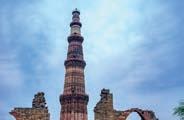
The Statue of Unity is in Gujarat.

When we visit monuments, we should keep them clean. We should not damage them.


Practice Time
1 Match the columns.
Monuments
Scan this QR code to see the quiz.
Where they are
a Sanchi Stupa Delhi
b Taj Mahal Gujarat
c Qutub Minar Telangana
d Charminar Uttar Pradesh
e Statue of Unity Madhya Pradesh
2 Name the monument and colour it. This monument is called .
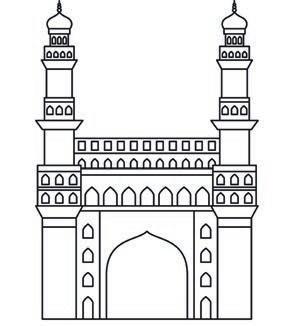
There are many days in the year that are celebrated all over the world. Let us learn about some of them.
The International Day of Happiness: 20 March
This day reminds us to be happy in whatever we do. It also tells us to do things that make others happy.





World Water Day: 22 March
This day is celebrated to remind us how important water is. We must not waste water.








World Health Day: 7 April
This day helps us to think of ways in which we can stay healthy.






Earth Day: 22 April







On this day, we learn how we must take care of the Earth. Trees are planted in many places on this day.



The International Day of Yoga: 21 June
On this day, we practice yoga to help us stay strong and healthy.















Can you think of one important day that was celebrated in your school? What was the day about?


Practice Time

Scan this QR code to see the quiz.
1 On what date are these days celebrated?
a World Health Day
b The International Day of Yoga
c World Water Day
d The International Day of Happiness
e Earth Day
2 Match the pictures and the international days.
Column A Column B

a World Health Day

b World Water Day

c The International Day of Happiness
People make beautiful and colourful designs on the floors. These are known as rangolis.
Rangolis are made during different festivals. They can be made using rice flour, flowers and petals, coloured powders and different beans.

A rangoli made with flowers. A rangoli made with coloured powders. Rangolis are made on festivals like Pongal, Onam, Durga Puja and Diwali.
Rangolis have different names in different parts of India. They are known as Kolam in Tamil Nadu and Alpona in West Bengal.
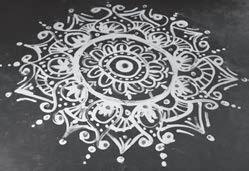

Do you know what a rangoli is called in your state? Use the internet to find out the answer.
Practice Time

Scan this QR code to see the quiz.
1 Tick () the things that are used to make a rangoli.
rice flour flowers wires water
coloured powders books beans boxes

2 Colour the rangoli.
Plants need sunlight and water to grow. Let us learn to grow a plant.
Things we need: Soil, pot, seed and water.



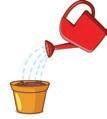


Watch your plant grow. Remember to take care of it every day.

Growing plants helps us save the environment.
Practice Time
Scan this QR code to see the quiz.
1 Rearrange the steps (1–4) to show how a plant grows.
Water the seeds.
Put the pot in the sunlight.
Put the soil in the pot.
Put the seeds in the soil.
2 Circle the differences between the two images.

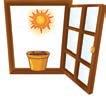










Each season is special. We have five seasons in India. Let us read about them.
The spring season is not very hot and not very cold. Trees and plants start to grow. There are many colourful flowers in spring.

The summer season is very hot. We wear cotton clothes. We love to eat ice cream. We get fruits like mangoes and watermelons in summer.

The monsoon season brings rain. We need a raincoat or an umbrella when we go out. We make paper boats.

The autumn season is dry. Leaves turn yellow. They fall from the trees. It starts to get a little cold in autumn.

The winter season is cold. We wear woollen clothes like sweaters and gloves. Snow falls in some places during winter.
Think about your favourite season. Talk to your friends about why you like it.
Practice Time
1 Match the following.
a Summer

b Winter
c Monsoon
Scan this QR code to see the quiz.



2 Circle the odd one out for the seasons.
a Summer: mango hot sweaters
b Monsoon: umbrella snowfall raincoat
c Winter: woollen clothes cotton shirt cold
d Autumn: yellow leaves rain dry
e Spring: raincoat colourful flowers trees and plants
We do a lot of things using different parts of our body. Let us learn about them.
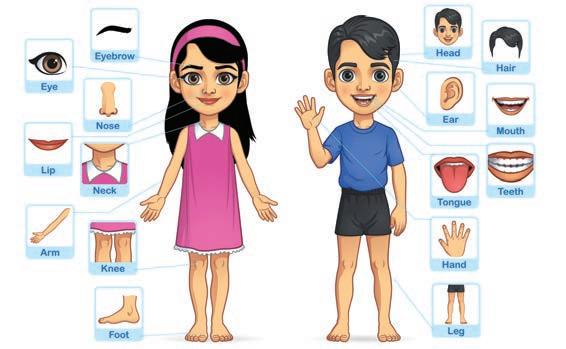









We use: teeth to chew. hands to touch and hold. legs to walk, run and jump. eyes to see. nose to smell. ears to hear. tongue to taste.
We should take care of our body. We should keep our body clean and eat healthy food.
Practice Time

Scan this QR code to see the quiz.
1 Look at the pictures. Rearrange the letters to write the correct names of the body parts.





2 Tick () the correct use of the body parts.
a eyes to smell to see
b tongue to chew to taste
c legs to walk to write
d ears to write to hear
e hands to talk to hold
f nose to smell to taste
g teeth to touch to chew

People have been doing folk dances for a very long time. There are different folk dances in India.
Ghoomar is a folk dance from Rajasthan. Bhangra is a folk dance from Punjab.
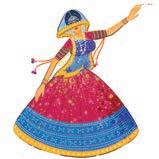
Lavani is a folk dance from Maharashtra.





Garba is a folk dance from Gujarat.
Bihu is a folk dance from Assam.
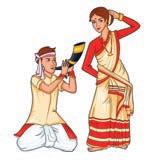

Find out the dance forms from your city or state.
Dance helps us to stay healthy and happy.
Practice Time

Scan this QR code to see the quiz.
1 Match the folk dances and the places they are from.
Dances Places
a Bhangra Assam
b Bihu Rajasthan
c Garba Punjab
d Ghoomar Gujarat
2 Look at the pictures of the folk dances. Write their names.
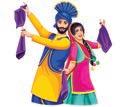
a b


c d

Greetings are different in different languages. Let us learn how people greet each other in different languages.
In India, we say Namaste in Hindi, Sata Sri Akal in Punjabi, Aadab in Urdu and Vanakkam in Tamil. There are many other greetings in India.
In England and America, people mainly speak English. They say Hello or Hi to greet each other.
In Spain, people mostly speak Spanish. They say Hola.
In France, most people speak French. They say Bonjour.








In China, people speak Chinese. They say Ni hao.
We should always greet people when we meet them.




Practice Time

Scan this QR code to see the quiz.
1 Match the greetings and the languages.
Greetings Languages
a Ni Hao French
b Namaste Urdu
c Aadab Tamil
d Bonjour Hindi
e Vanakkam Chinese
2 Sam is from England. Nazir is from Spain. Mia is from France. In the boxes, write the greetings that they use in their countries.
Greetings!
We use a lot of different things in our daily lives. Let us learn more about the things we need and the things we want.
Needs are the things that are important for us to live. Without them, we cannot live a healthy life. Some of the needs are:
Wants are the things that we like to have. We can live without them. They just make our life more fun. Some of the wants are:














We should take care of what we need first, before we think about what we want. This will help us be happy.
Practice Time

Scan this QR code to see the quiz.
1 Write ‘N’ for the things that we need and ‘W’ for the things that we want.





2 Help Tanmay reach the thing that he needs.



1. Food from Plants
1. Pulse Spice Grain Vegetable




2. Computer and Its Parts
1. a. (i) study b. (ii) keyboard
2. a. Monitor b. CPU c. Keyboard d. Mouse
3. Our National Flag
1. white, green, blue, saffron
2. Republic Day, Independence Day
4. In the Park
1. a. seesaw
Animals and Birds
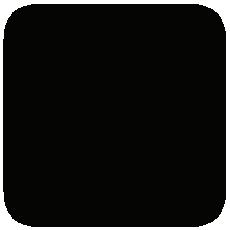
b. monkey bars
5. Traffic Signals 1. You can park

2. Ostrich
Zebra 7. Travel in a City
Elephant


e. Eid ul-Fitr 9. Different Sports
2. a. table tennis b. lawn tennis
c. hockey d. badminton e. cricket
10. Make a Dish
1. a. mint leaves, lemons, sugar
b. Cheese slices, bread slices
2.

11. ICC Men’s T20 World Cup, 2024
1. a. (i) India b. (ii) Rohit Sharma
c. (i) Jasprit Bumrah d. (i) 20
12. At the Beach
1. seashells, sand, trees, starfish, waves
13. Look Up!
1. a. west b. dark c. seven d. shape
e. Stars
14. Musical Instruments
1. a. Harmonium b. Bansuri
15. What Is Money? 1.






2. a. T b. F c. T d. F e. T
16. India and Its Neighbours
1. China, Sri Lanka, Bangladesh, Nepal
17. Cartoons We Like
1. a. Dora the Explorer b. Masha
c. Motu and Patlu d. Doraemon
e. Chhota Bheem
18. Stay Fit
1. running, playing outside, taking proper rest
19. India at the Olympics, 2024
1. a. (ii) Paris b. (i) four c. (i) six
d. (ii) silver e. (i) bronze
20. Sorting Waste
1.
Sitar
2. tabla
2. a. plastic bottles b. batteries
c. leftover food
21. Machines Around Us










26. Seasons
1. a. Summer
b. Winter





2. a. (iii) fridge b. (iii) iron c. (iii) car
22. Monuments of India
1. Monuments Where they are
a. Sanchi Stupa Delhi
b. Taj Mahal Gujarat
c. Qutub Minar Telangana
d. Charminar Uttar Pradesh
e. Statue of Unity Madhya Pradesh
2. Charminar
23. Important International Days
1. a. 7 April b. 21 June c. 22 March
d. 20 March e. 22 April
2. Column A Column B
c. Monsoon

2. a. sweaters b. snowfall c. cotton shirt
d. rain e. raincoat
27. My Body Parts
1. a. EYE b. EAR c. LEGS d. NOSE
e. HAND
2. a. to see b. to taste c. to walk
d. to hear e. to hold f. to smell
g. to chew
28. Folk Dances
1. Dances Places
a. Bhangra Assam
a. World Health Day

b. Bihu Rajasthan
c. Garba Punjab
b. World Water Day

d. Ghoomar Gujarat
2. a. Bhangra b. Bihu c. Garba d. Lavani

c. The International Day of Happiness
24. Rangoli
1. Rice flour, flowers, coloured powders, beans
25. Growing Plants
1. 3, 4, 1, 2
29. Greetings!
1. Greetings Languages
a. Ni Hao French
b. Namaste Urdu
c. Aadab Tamil
d. Bonjour Hindi
e. Vanakkam Chinese
2. Sam- Hello or Hi, Nazir- Hola, Mia- Bonjour


Introducing Aware, a comprehensive and engaging General Knowledge and Current Affairs book designed specifically for learners in grades 1 to 8. It empowers learners with general knowledge, awareness of global developments, functional competencies and the 21st-century skills essential for life today. This book spans nine thoughtfully curated themes.

Uolo partners with K-12 schools to provide technology-enabled learning programs. We believe that pedagogy and technology must come together to deliver scalable learning experiences that generate measurable outcomes. Uolo is trusted by over 15,000+ schools across India, Southeast Asia and the Middle East.
ISBN 978-81-980193-1-8
